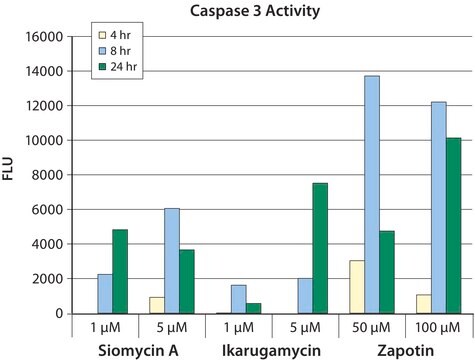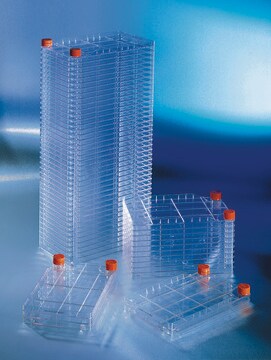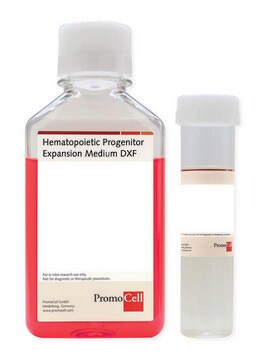APT503
CaspaTag Caspase 3,7 In Situ Assay Kit, Sulforhodamine
About This Item
Polecane produkty
reaktywność gatunkowa (przewidywana na podstawie homologii)
mammals
Poziom jakości
producent / nazwa handlowa
CaspaTag
Chemicon®
metody
activity assay: suitable
flow cytometry: suitable
immunofluorescence: suitable
numer dostępu NCBI
metoda wykrywania
fluorometric
Warunki transportu
wet ice
informacje o genach
human ... CASP3(836)
Opis ogólny
Kaspazy zostały zidentyfikowane w organizmach od C. elegans do ludzi. Kaspazy ssaków odgrywają różne role w apoptozie i stanach zapalnych. W apoptozie, kaspazy są odpowiedzialne za proteolityczne rozszczepienia, które prowadzą do demontażu komórki (kaspazy efektorowe) i są zaangażowane w poprzedzające zdarzenia regulacyjne (kaspazy inicjatorowe). Aktywna kaspaza składa się z dwóch dużych i dwóch małych podjednostek, które tworzą dwa heterodimery łączące się w tetramer2-4. Podobnie jak inne proteazy, kaspazy są syntetyzowane jako prekursory, które ulegają dojrzewaniu proteolitycznemu, autokatalitycznie lub w kaskadzie przez enzymy o podobnej specyficzności5.
Enzymy kaspazowe specyficznie rozpoznają sekwencję 4 lub 5 aminokwasów na docelowym substracie, która koniecznie zawiera resztę kwasu asparaginowego. Reszta ta jest celem rozszczepienia, które zachodzi na karbonylowym końcu reszty kwasu asparaginowego6. Kaspazy mogą być wykrywane poprzez immunoprecypitację, techniki immunoblottingu przy użyciu przeciwciał specyficznych dla kaspaz lub poprzez zastosowanie substratów fluorochromowych, które stają się fluorescencyjne po rozszczepieniu przez kaspazę.
Zasada testu:
Zestawy CHEMICON do wykrywania kaspaz in situ wykorzystują nowatorskie podejście do wykrywania aktywnych kaspaz. Metodologia opiera się na fluorochromowych inhibitorach kaspaz (FLICA). Inhibitory są przepuszczalne dla komórek i niecytotoksyczne. Po wejściu do komórki inhibitor wiąże się kowalencyjnie z aktywną kaspazą 7. Ten zestaw wykorzystuje znakowany karboksyfluoresceiną fluorometyloketonowy peptydowy inhibitor kaspazy-3 (SR-DEVD-FMK), który wytwarza zieloną fluorescencję. Po dodaniu do populacji komórek, sonda SR-DEVD-FMK wchodzi do każdej komórki i kowalencyjnie wiąże się z reaktywną resztą cysteiny, która znajduje się na dużej podjednostce aktywnego heterodimeru kaspazy, hamując w ten sposób dalszą aktywność enzymatyczną. Związany znakowany odczynnik jest zatrzymywany w komórce, podczas gdy niezwiązany odczynnik dyfunduje z komórki i jest wypłukiwany. Zielony sygnał fluorescencyjny jest bezpośrednią miarą ilości aktywnej kaspazy-3 obecnej w komórce w momencie dodania odczynnika. Komórki zawierające związany znakowany odczynnik mogą być analizowane za pomocą 96-dołkowej fluorometrii, mikroskopii fluorescencyjnej lub cytometrii przepływowej.
Zastosowanie:
CHEMICON In Situ FLICA Caspase-3 Detection Kit to oparty na fluorescencji test do wykrywania aktywnej kaspazy-3 w komórkach przechodzących apoptozę. Zestaw jest przeznaczony wyłącznie do użytku badawczego. Nie jest przeznaczony do stosowania w procedurach diagnostycznych lub terapeutycznych.
Zastosowanie
Apoptosis & Cancer
Komponenty
10X Wash Buffer: 60 mL
Fixative: 6 mL
Hoechst Stain: 1 mL at 200 μg/mL, ready-to-use
Przechowywanie i stabilność
- Odtworzony odczynnik FLICA (150X) należy zamrozić w temperaturze -20°C na okres do 6 miesięcy i w tym czasie można go dwukrotnie rozmrozić. W razie potrzeby rozdzielić do oddzielnych bursztynowych probówek. Chronić przed światłem przez cały czas.
- Przechowywać rozcieńczony (1X) bufor płuczący w temperaturze do -20ºC przez 2 tygodnie.
Informacje prawne
Oświadczenie o zrzeczeniu się odpowiedzialności
Hasło ostrzegawcze
Danger
Zwroty wskazujące rodzaj zagrożenia
Zwroty wskazujące środki ostrożności
Klasyfikacja zagrożeń
Acute Tox. 3 Inhalation - Acute Tox. 4 Dermal - Acute Tox. 4 Oral - Carc. 1B - Eye Irrit. 2 - Muta. 2 - Skin Irrit. 2 - Skin Sens. 1 - STOT SE 2 - STOT SE 3
Organy docelowe
Eyes,Central nervous system, Respiratory system
Kod klasy składowania
6.1C - Combustible acute toxic Cat.3 / toxic compounds or compounds which causing chronic effects
Certyfikaty analizy (CoA)
Poszukaj Certyfikaty analizy (CoA), wpisując numer partii/serii produktów. Numery serii i partii można znaleźć na etykiecie produktu po słowach „seria” lub „partia”.
Masz już ten produkt?
Dokumenty związane z niedawno zakupionymi produktami zostały zamieszczone w Bibliotece dokumentów.
Nasz zespół naukowców ma doświadczenie we wszystkich obszarach badań, w tym w naukach przyrodniczych, materiałoznawstwie, syntezie chemicznej, chromatografii, analityce i wielu innych dziedzinach.
Skontaktuj się z zespołem ds. pomocy technicznej










